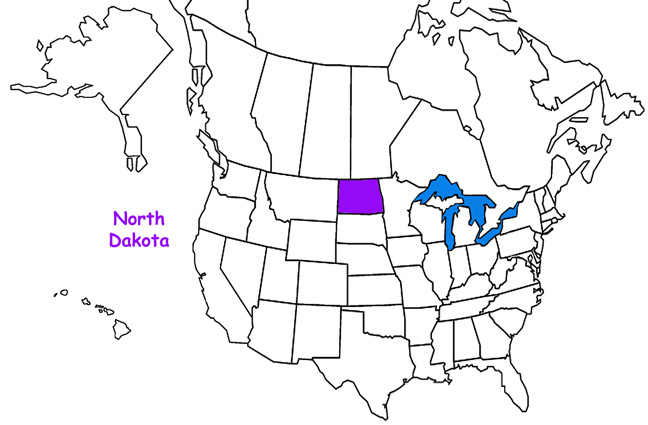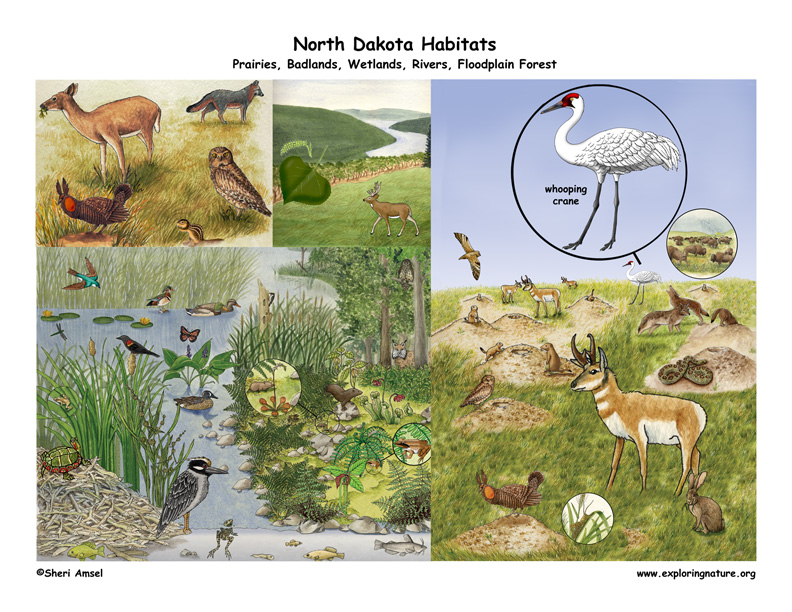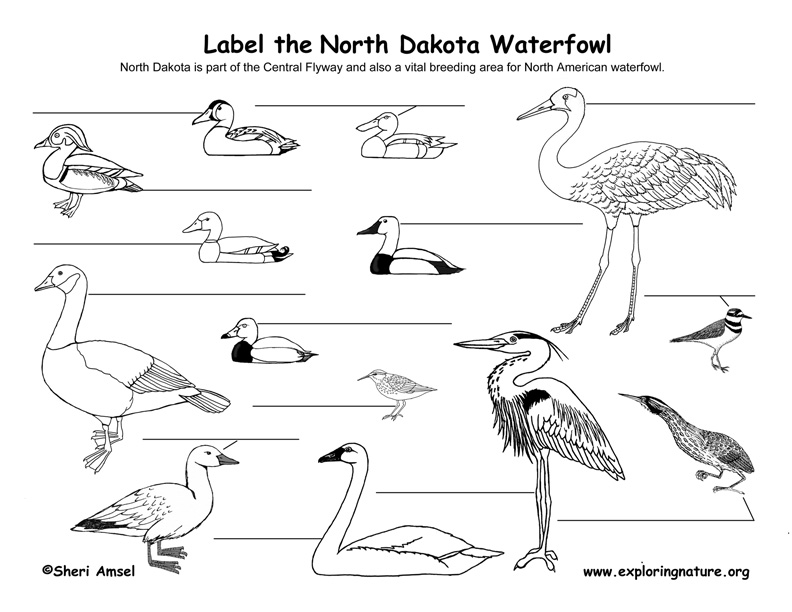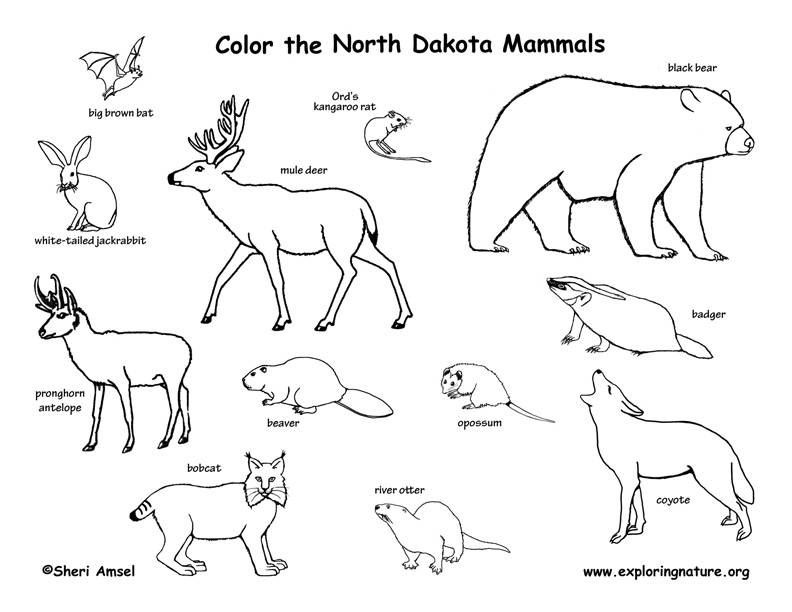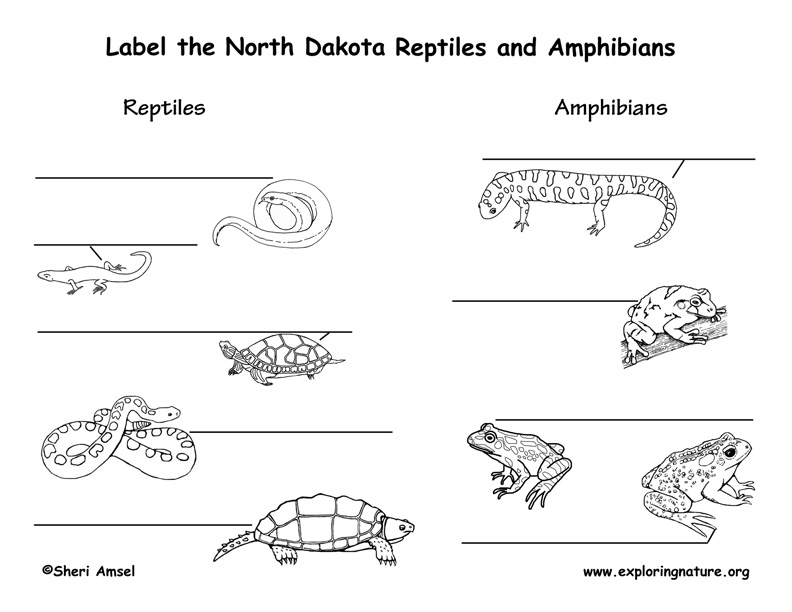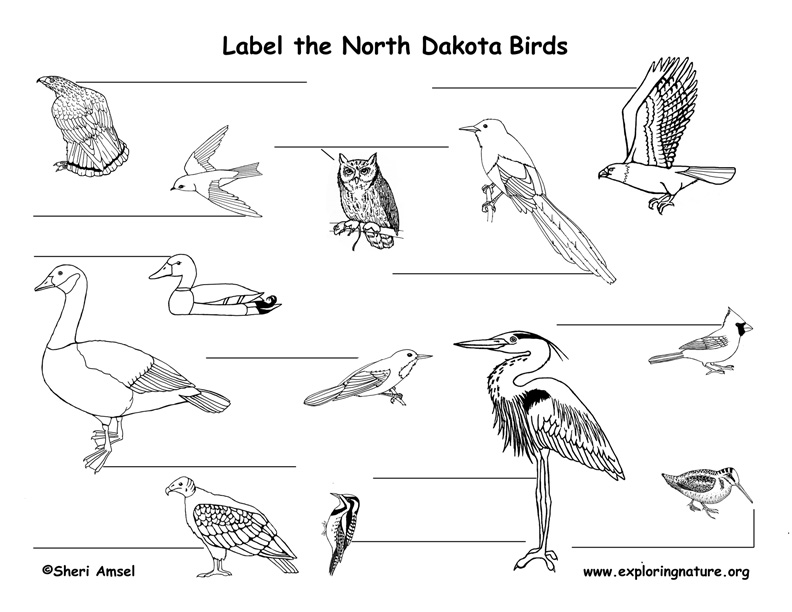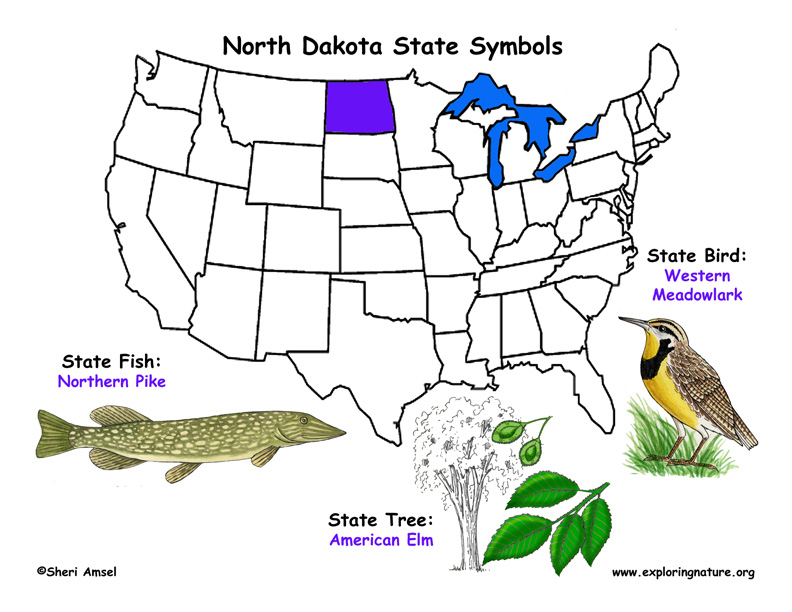

North Dakota is a grassland state, but the terrain is not all the same. If traveling through North Dakota from west to east, you would first cross the Missouri Plateau. This is the high point of the state, a great rolling plain of short and mixed-grass prairie broken only by the hills and buttes of the badlands. Next, you would cross over the Missouri Coteau and then step down onto the Drift Prairie. The Drift Prairie is an open plain of mixed-grass prairie with "drifts" of rock and soil left by the retreating glaciers. Moving east, you would then step down onto the flatlands of the Red River Valley, which is really the floor of an ancient glacial lake called Lake Agassiz and covered with tallgrass prairie.
Grasslands are important habitats for wildlife providing food and shelter. North Dakota's landscape is dominated by grasslands (instead of forest) because of the low rainfall. In addition, historically, grazing wildlife (especially bison) and periodic wildfires kept the prairie open. The thick mat of prairie grass roots underground sprout quickly after a fire and are fertilized by the ashes. Before the European settlers started farming in the late 1800s, North Dakota had more than 2-million acres of tallgrass prairie. Today, less than 10% of that remains. The Little Missouri National Grasslands in western North Dakota is a National Park with more than 1-million acres of preserved grassland.
North Dakota's Badlands are located in the Little Missouri National Grasslands. The Badlands is an area of eroded land by the Missouri River, wind and rainfall. The interesting terrain of the Badlands includes beautifully colored rock formations, canyons, buttes and outcroppings. The badlands were protected from early farming and development because of the rugged terrain. Because a shallow sea once covered North Dakota (250-500 million years ago), fossils of sharks, fish and ancient plants are often uncovered in the eroded Badlands. Later (65 million years ago), the seas drained and left swamps and for forests. This was the age of the dinosaur making the Badlands an important site for discovering dinosaur fossils and petrified wood.
The layers of past animals and plants were compressed by the rising and falling sea and over millions of years developed into deposits of petroleum and coal. Oil wells to retrieve some of these valuable resources are not uncommon, but much of the Badlands are now protected as a National Park.
There are few forests in North Dakota, but they do exist near water - in river valleys, Badland ravines, and floodplains (also called bottomlands). In the floodplains, there are bottomland deciduous forests of ash, elm, box elder, bur oak, quaking aspen, cottonwood and ironwood. In the Badlands, there are western conifer forests of ponderosa pine, cedar, limber pine and Rocky Mountain juniper.
North Dakota is part of the Central Flyway and also a vital breeding area for North American waterfowl. Wetlands are very important habitats. They provide valuable wildlife habitat, stabilize shorelines and protect the land from storm surges and flooding. They act as filters to pollutants that run off the land from farms, towns and cities. Yet, for generations, people saw wetlands as dangerous and wasted land and set about filling them in and covering them over. It wasn't until late in the 1900s that people realized the vital importance of wetlands and set about protecting and reclaiming them. Historically, North Dakota had about 5 million acres of wetlands covering about 11% of the state. Today only half remain.
For more information about North Dakota's habitats (off-site) resource: LINK
antelope (pronghorn)
badger
bat (big brown)
bat (hoary)
bat (little brown myotis)
bat (long-eared)
bat (long-legged myotis)
bat (northern myotis)
bat (red)
bat (silver-haired)
bat (Townsend's big-eared)
bat (western small-footed)
beaver
bobcat
chipmunk (eastern)
chipmunk (least)
coyote
deer (mule)
deer (white-tailed)
ermine (short-tailed weasel)
fisher - rare
fox (gray)
fox (red)
fox (swift)
ground squirrel (Franklin's)
ground squirrel (Richardson's)
ground squirrel (thirteen-lined)
hare (snowshoe)
jackrabbit (white-tailed)
kangaroo rat (Ord's)
lynx (Canadian)
marten - rare
mink
moose
mouse (deer)
mouse (house)
mouse (meadow jumping)
mouse (northern grasshopper)
mouse (olive-backed pocket)
mouse (plains harvest)
mouse (plains pocket)
mouse (western harvest)
mouse (western jumping)
mouse (white-footed)
muskrat
opossum (Virginia)
otter (river)
pocket gopher (hispid)
pocket gopher (northern)
pocket gopher (plains)
porcupine
prairie dog (black-tailed)
rabbit (desert cottontail)
rabbit (eastern cottontail)
rabbit (Nuttall's)
raccoon
rat (Norway)
shrew (Arctic)
shrew (masked)
shrew (Merriam's)
shrew (northern short-tailed)
shrew (pygmy)
shrew (water)
skunk (eastern spotted)
skunk (striped)
squirrel (gray)
squirrel (fox)
squirrel (northern flying)
squirrel (red)
vole (meadow)
vole (prairie)
vole (sagebrush) - rare
vole (southern red-backed)
weasel (least)
weasel (long-tailed)
woodchuck
woodrat (bushy-tailed)
For more information about North Dakota's mammals (including Latin names) click on individual animal links or for another (off-site) resource: LINK
http://www.mammalsociety.org/mammals-north-dakota
Mammals Now Extinct in North Dakota:
bear (black)
bear (grizzly)
bison
caribou
elk (American)
ferret (black-footed)
mountain lion
mountain sheep
wolf (gray)
wolverine
For more information about North Dakotas mammals (including Latin names) click on individual animal links or for another (off-site) resource: LINK
Amphibians
frog (northern leopard)
frog (western chorus)
frog (wood)
muddpuppy
salamander (blotched tiger)
salamander (eastern tiger)
salamander (gray tiger)
spadefoot (plains)
toad (American)
toad (Canadian)
toad (Great Plains)
toad (Woodhouse's)
treefrog (gray)
Reptiles
lizard (sagebrush)
lizard (short-horned)
skink (northern prairie)
snake (bull)
snake (common garter)
snake (plains garter)
snake (prairie rattlesnake)
snake (racer)
snake (redbelly)
snake (smooth green)
snake (western hognose)
turtle (common snapping)
turtle (false map)
turtle (smooth softshell)
turtle (western painted)
avocet (American)
bittern (American)
bittern (least)
blackbird (Brewer's)
blackbird (red-winged)
blackbird (rusty)
blackbird (yellow-headed)
bluebird (eastern)
bluebird (mountain)
bobolink
brambling
bunting (indigo)
bunting (lark)
bunting (Lazuli)
bunting (snow)
cardinal (northern)
catbird (gray)
chickadee (black-capped)
chickadee (boreal)
coot (American)
cormorant (double-crested)
cowbird (brown-headed)
crane (sandhill)
crane (whooping)
creeper (brown)
crossbill (red)
crossbill (white-winged)
crow (American)
cuckoo (black-billed)
cuckoo (yellow-billed)
curlew (Eskimo)
curlew (long-billed)
dickcissel
dove (mourning)
dove (rock)
dowitcher (long-billed)
dowitcher (short-billed)
duck (American black)
duck (American wigeon)
duck (Barrow's goldeneye)
duck (black scoter)
duck (blue-winged teal)
duck (bufflehead)
duck (canvasback)
duck (cinnamon teal)
duck (common goldeneye)
duck (common eider)
duck (Eurasian wigeon)
duck (fulvous whistling)
duck (gadwall)
duck (greater scaup)
duck (green-winged teal)
duck (harlequin)
duck (lesser scaup)
duck (mallard)
duck (northern pintail)
duck (northern shoveler)
duck (oldsquaw)
duck (redhead)
duck (ring-necked)
duck (ruddy)
duck (surf scoter)
duck (white-winged scoter)
duck (wood)
eagle (bald)
eagle (golden)
egret (cattle)
egret (great)
egret (snowy)
falcon (gyrfalcon)
falcon (peregrine)
falcon (prairie)
finch (gray-crowned rosy)
finch (house)
finch (purple)
flicker (northern)
flycatcher (alder)
flycatcher (great-crested)
flycatcher (least)
flycatcher (olive-sided)
flycatcher (scissor-tailed)
flycatcher (willow)
flycatcher (yellow-bellied)
gnatcatcher (blue-gray)
godwit (Hudsonian)
godwit (marbled)
goldfinch (American)
goldfinch (lesser)
goose (Brant)
goose (Canada)
goose (greater white-fronted)
goose (Ross's)
goose (snow)
grackle (common)
grebe (eared)
grebe (horned)
grebe (pied-billed)
grebe (red-necked)
grebe (western)
grosbeak (black-headed)
grosbeak (blue)
grosbeak (evening)
grosbeak (pine)
grosbeak (rose-breasted)
grouse (ruffed)
grouse (sage)
grouse (sharp-tailed)
gull (Bonaparte's)
gull (California)
gull (Franklin's)
gull (glaucous)
gull (herring)
gull (ring-billed)
gull (Sabine's)
gull (Thayer's)
harrier (northern)
hawk (broad-winged)
hawk (Cooper's)
hawk (ferruginous)
hawk (northern goshawk)
hawk (red-shouldered)
hawk (red-tailed)
hawk (rough-legged)
hawk (sharp-shinned)
hawk (Swainson's)
heron (black-crowned night)
heron (great blue)
heron (little blue)
heron (green)
heron (tricolored)
heron (yellow-crowned night)
hummingbird (ruby-throated)
ibis (white)
ibis (white-faced)
jaeger (long-tailed)
jaeger (pomarine)
jay (blue)
jay (gray)
jay (pinyon)
junco (dark-eyed)
kestrel (American)
killdeer
kingbird (eastern)
kingbird (western)
kingfisher (belted)
kinglet (golden-crowned)
kinglet (ruby-crowned)
kite (American swallow-tailed)
kittiwake (black-legged)
lark (horned)
longspur (chestnut-collared)
longspur (Lapland)
longspur (McCown's)
longspur (Smith's)
loon (common)
loon (red throated)
magpie (black-billed)
marten (purple)
meadowlark (eastern)
meadowlark (western)
merganser (common)
merganser (hooded)
merganser (red-breasted)
merlin
mockingbird (northern)
nighthawk (common)
nutcracker (Clark's)
nuthatch (red-breasted)
nuthatch (white-breasted)
oriole (northern)
oriole (orchard)
osprey
ovenbird
owl (barn)
owl (barred)
owl (boreal)
owl (burrowing)
owl (eastern screech)
owl (great gray)
owl (great horned)
owl (long-eared)
owl (northern hawk)
owl (northern saw-whet)
owl (short-eared)
owl (snowy)
partridge (gray)
parula (northern)
pelican (American white)
pelican (brown)
phalarope (red)
phalarope (red-necked)
phalarope (Wilson's)
pheasant (ring-necked)
phoebe (eastern)
phoebe (Say's)
pine siskin
pipit (American)
pipit (Sprague's)
plover (American golden)
plover (black-bellied)
plover (mountain)
plover (piping)
plover (semipalmated)
poorwill (common)
prairie-chicken (greater)
ptarmigan (willow)
rail (king)
rail (Virginia)
rail (yellow)
raven (common)
red knot
redpoll (common)
redpoll (hoary)
redstart (American)
robin (American)
ruff
sanderling
sandpiper (Baird's)
sandpiper (buff-breasted)
sandpiper (curlew)
sandpiper (least)
sandpiper (pectoral)
sandpiper (semipalmated)
sandpiper (solitary)
sandpiper (spotted)
sandpiper (stilt)
sandpiper (upland)
sandpiper (western)
sandpiper (white-rumped)
shrike (loggerhead)
shrike (northern)
snipe (common)
solitaire (Townsend's)
sora
sparrow (American tree)
sparrow (Baird's)
sparrow (Brewer's)
sparrow (chipping)
sparrow (clay-colored)
sparrow (field)
sparrow (fox)
sparrow (golden-crowned)
sparrow (grasshopper)
sparrow (Harris's)
sparrow (Henslow's)
sparrow (house)
sparrow (lark)
sparrow (LeConte's)
sparrow (Lincoln's)
sparrow ( sharp-tailed)
sparrow (Savannah)
sparrow (song)
sparrow (swamp)
sparrow (vesper)
sparrow (white-crowned)
sparrow (white-throated)
starling (European)
stilt (black-necked)
stork (wood)
swallow (bank)
swallow (barn)
swallow (cliff)
swallow (north rough-winged)
swallow (tree)
swallow (violet-green)
swan (trumpeter)
swan (tundra)
swift (chimney)
tanager (scarlet)
tanager (summer)
tanager (western)
tern (black)
tern (Caspian)
tern (common)
tern (Forster's)
tern (least)
towhee (green-tailed)
towhee (rufous-sided)
thrasher (brown)
thrasher (sage)
thrush (gray-cheeked)
thrush (hermit)
thrush (Swainson's)
thrush (varied)
thrush (wood)
turkey (wild)
turnstone (ruddy)
veery
vireo (Bell's)
vireo (Philadelphia)
vireo (red-eyed)
vireo (solitary)
vireo (warbling)
vireo (white-eyed)
vireo (yellow-throated)
vulture (turkey)
warbler (bay-breasted)
warbler (black and white)
warbler (Blackburnian)
warbler (blackpoll)
warbler (black-throated blue)
warbler (black-throated green)
warbler (blue-winged)
warbler (Canada)
warbler (Cape May)
warbler (cerulean)
warbler (chestnut-sided)
warbler (Connecticut)
warbler (golden-winged)
warbler (hooded)
warbler (MacGillivray's)
warbler (magnolia)
warbler (mourning)
warbler (Nashville)
warbler (orange-crowned)
warbler (palm)
warbler (pine)
warbler (prothonotary)
warbler (Tennessee)
warbler (Townsend's)
warbler (Wilson's)
warbler (worm-eating)
warbler (yellow)
warbler (yellow-rumped)
waterthrush (Louisiana)
waterthrush (northern)
waxwing (Bohemian)
waxwing (cedar)
whimbrel
whip-poor-will
willet
woodcock (American)
woodpecker (black-backed)
woodpecker (downy)
woodpecker (hairy)
woodpecker (Lewis's)
woodpecker (pileated)
woodpecker (red-bellied)
woodpecker (red-headed)
woodpecker (yellow-bellied sapsucker)
wood-pewee (eastern)
wood-pewee (western)
wren (house)
wren (marsh)
wren (rock)
wren (sedge)
wren (winter)
yellowlegs (greater)
yellowlegs (lesser)
yellowthroat (common)
When you research information you must cite the reference. Citing for websites is different from citing from books, magazines and periodicals. The style of citing shown here is from the MLA Style Citations (Modern Language Association).
When citing a WEBSITE the general format is as follows.
Author Last Name, First Name(s). "Title: Subtitle of Part of Web Page, if appropriate." Title: Subtitle: Section of Page if appropriate. Sponsoring/Publishing Agency, If Given. Additional significant descriptive information. Date of Electronic Publication or other Date, such as Last Updated. Day Month Year of access < URL >.
Amsel, Sheri. "North Dakota Habitats, Mammals, Birds, Amphibians, Reptiles" Exploring Nature Educational Resource ©2005-2024. December 31, 2024
< http://www.exploringnature.org/db/view/840 >
